Italian Sourdough Starter – Lievito Madre Recipe
Italian Sourdough Starter – Lievito Madre Recipe is made a little bit different then the more well known version. This is a lower hydration starter which also takes longer to produce. But it is well worth it.

So after making a Sourdough Starter that most of us usually use, I decided that I wanted to also give the Italian version, Lievito Madre a try. A friend explained how it is made and here is the result. Time is needed but it is very easy and straight forward.
How to make it
Step 1
In a small bowl mix together the lukewarm water and honey, then add the flour and make a non sticky dough ball
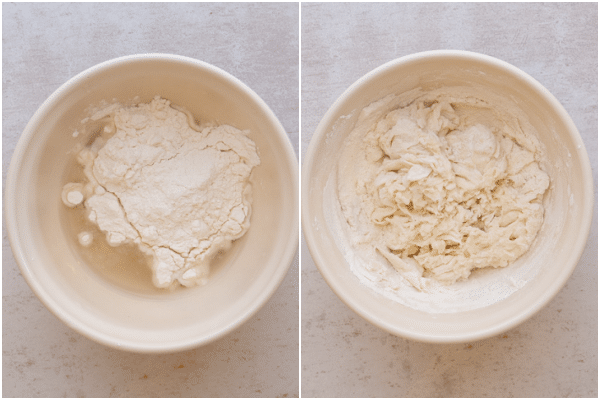
Mark with a cross. Then place in a large glass jar, place lid on top but do not close. Let sit in a warm draft free area for 48 hours.

Step 2
Remove 100 grams of the dough, it’s best to remove the top part of the dough which tends to be dry, then keep 100 grams of the remaining dough (discard anything over the 100 grams), place in a bowl and add the flour and water, knead to form a compact dough, make a cross. Place in the jar (which has been cleaned, rinsed well and dried). Cover lightly and let rest again for 48 hours.
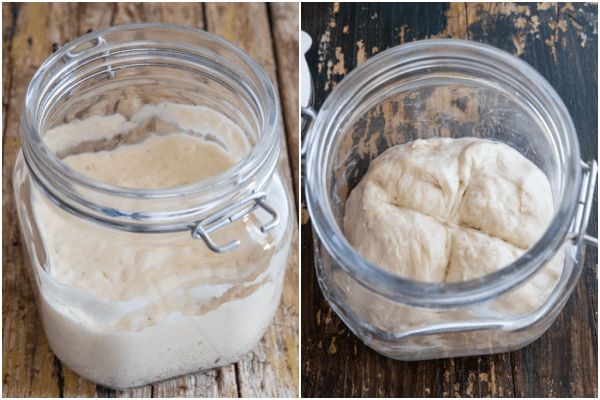
Step 3
Remove 100 grams of the dough, it’s best to remove the top part of the dough which tends to be dry, then keep 100 grams of the remaining dough (discard anything over the 100 grams), place in a bowl and add the flour and water, knead to form a compact dough, make a cross. Place in the jar (which has been cleaned, rinsed well and dried). Cover lightly and let rest again for 48 hours.

Step 4
Remove 100 grams of the dough, it’s best to remove the top part of the dough which tends to be dry, then keep 100 grams of the remaining dough (discard anything over the 100 grams), place in a bowl and add the flour and water, knead to form a compact dough, make a cross. Place in the jar (which has been cleaned, rinsed well and dried). Cover lightly and let rest again for 48 hours.
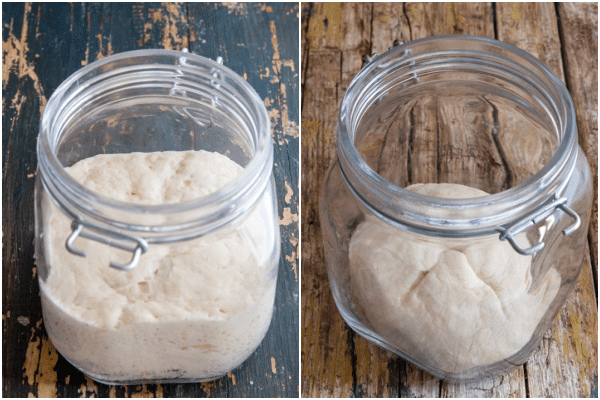
Step 5
Remove 100 grams of the dough, it’s best to remove the top part of the dough which tends to be dry, then keep 100 grams of the remaining dough (discard anything over the 100 grams), place in a bowl and add the flour and water, knead to form a compact dough, make a cross. Place in the jar (which has been cleaned, rinsed well and dried). Cover lightly and let rest again for 24 hours.

Step 6
Again remove 100 grams of the dough, it’s best to remove the top dry part of the dough, then keep 100 grams of the remaining dough (discard anything over the 100 grams), place in a bowl and add the flour and water, knead to form a compact dough, make a cross. Place in the jar (which has been cleaned, rinsed well and dried). Cover lightly and let rest again for 24 hours.
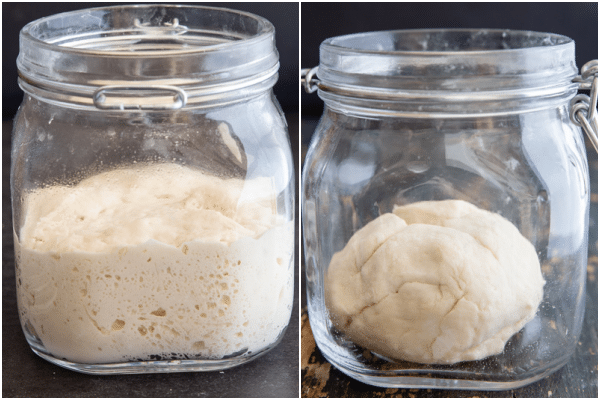
Step 7
Again remove 100 grams of the dough, it’s best to remove the top dry part of the dough, then keep 100 grams of the remaining dough (discard anything over the 100 grams), place in a bowl and add the flour and water, knead to form a compact dough, make a cross. Place in the jar (which has been cleaned, rinsed well and dried). Cover lightly and let rest again for 24 hours.
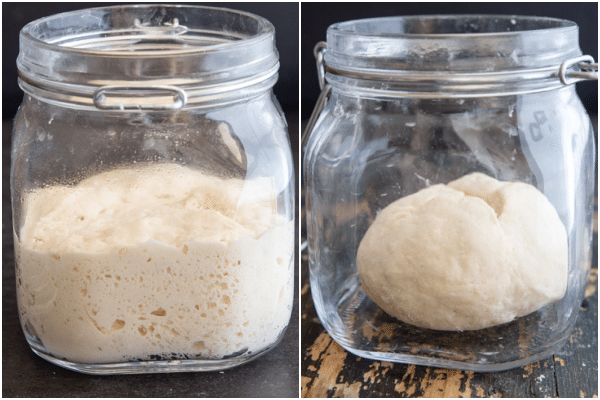
Step 8
Again remove 100 grams of the dough, it’s best to remove the top dry part of the dough, then keep 100 grams of the remaining dough (discard anything over the 100 grams), place in a bowl and add the flour and water, knead to form a compact dough, make a cross. Place in the jar (which has been cleaned, rinsed well and dried). Cover lightly and let rest again for 24 hours.
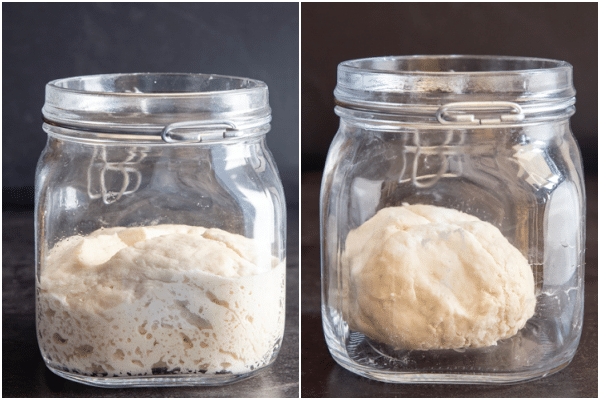
Step 9
Again remove 100 grams of the dough, it’s best to remove the top part of the dough, then keep 100 grams of the remaining dough (discard anything over the 100 grams), (from today on discard can be used for baking), place in a bowl and add the flour and water, knead to form a compact dough, make a cross. Place in the jar (which has been cleaned, rinsed well and dried). Cover lightly and let rest again for 24 hours.

Step 10
Again remove 100 grams of the dough, it’s best to remove the top dry part of the dough, then keep 100 grams of the remaining dough (discard anything over the 100 grams), place in a bowl and add the flour and water, knead to form a compact dough, make a cross. Place in the jar (which has been cleaned, rinsed well and dried). Cover lightly and let rest again for 24 hours.
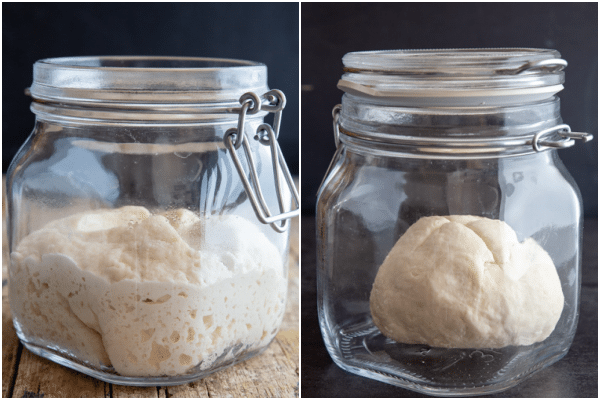
Step 11
Again remove 100 grams of the dough, it’s best to remove the top dry part of the dough, then keep 100 grams of the remaining dough (discard anything over the 100 grams), place in a bowl and add the flour and water, knead to form a compact dough, make a cross. Place in the jar (which has been cleaned, rinsed well and dried). Cover lightly and let rest again for 24 hours.

Step 12
Ready to use!

The few days you probably won’t notice much difference in growth but the yeast will be stronger.
What is the best jar to use?
The best jar to use is a glass jar with a lid, it’s best to have one that is large enough that you can stick your hand in.
Why is a Natural Starter a better choice?
A natural starter or sourdough starter gives a more intense flavour to your bread recipe. You will also have a better developed crumb, which helps the bread to grow in height rather than width. It also has a better shelf life, this is because of the level of acidity of the dough which tends to inhibit most of the moulds, it also keeps its aroma for a longer period and has a more appealing crust colour.
Some people find (me included) that it is easier to digest because of the the transformation of the more complex substances into simpler ones, therefore it makes it easier for our bodies to absorb.
What equipment do you need?
To get everything set up to start, you are going to need, a good quality all purpose or bread flour (unbleached), chlorine free water (bottled or filtered), a scale – because I think working in grams is best for bread, a thermometer, a large jar with a lid.
Why make a cross in the dough?
The cross, according to popular superstition, was used to bless the dough of bread and to drive out demons or evil forces that would have hindered the leavening. In fact, it is said that having received from the Pope, the order to bless the loaves, Saint Clare made the sign of the cross on them. So a little Italian superstition never hurt!
What is the best room temperature for the starter?
The starter should be kept in a warmish room, the best temperature would be anywhere from 70-85F (21-30C).
What are some of the differences between the two starters?
- Lievito Madre is a much firmer starter, more like a dough.
- There will be no liquid (hooch) produced this way.
- I find the aroma is not as strong.
Why is the starter dough discarded?
The starter is discarded so that there is less flour needed to maintain it. If you just added the same amount of flour each time you refresh the stater (without removing any starter), you would eventually come to a point where the added flour is not enough to refresh the starter and it would starve.
The starter is not a real starter until you have arrived at about step 9 or 10 and sometimes longer. It takes time for the organism balance to get established.
What to make with discarded starter
Lots of people, me included would rather not throw away food, (but unfortunately you will have to eliminate some of that starter at the beginning), and that goes for discarded starter, here are a few ideas that you can use with it. A fast and simple one is frying it, sprinkle with your favourite spices and fry in some oil. You could share it with friends once it is developed.
Or you could refrigerate it and keep adding the discard until you have enough for a recipe (recipes to follow). It will last up to 2-3 months in the fridge.
What to do when the starter is active
Once the starter is active the first thing to do is give it a name, yes people name their starters. Then you can refrigerate the starter especially if you plan on baking bread about once a week. If you plan on baking everyday then the starter should be kept on the counter. And fed once a day.
How to store the Lievito Madre
Store it in a clean glass or another container that is suitable for food, it should be at least three times larger than the starter. Do not close it tightly, leave it in the refrigerator until the next use, remember to refresh it every 5-7 days at the most if not using.
How to refresh the starter
Remove the starter from the refrigerator and leave it at room temperature for an hour , if your house is cooler then extend the time to about 2 hours. Eliminate the top layer of the dough, which may be dry and crusty. Remove 100 grams, add 50 grams of water and 105 grams of flour. knead the dough until you get a compact dough.
Engrave a cross on the dough and place it in the clean glass jar. Let it sit at room temperature until it has doubled (3-4 hours) then place it back in the fridge.
How to bake with a refrigerated starter
When you want to use the starter, it must be refreshed, a part will then be used and a part will be kept in the refrigerator for subsequent uses. To refresh the starter for use, proceed in this way.
Remove the starter from the refrigerator and leave it at room temperature for an hour or two (it also depends on the warmth of your room). Sometimes an extra hour is needed.
If needed remove the top layer of the dough (the dry part), weigh the dough, and feed with the same amount of flour (for example if it weighs 100 grams I feed with 100 grams of flour, I sometimes use 70 grams bread and 30 grams whole wheat), and about half the amount of water (so it would be 45-50 grams of water lukewarm) and 1/4 teaspoon of honey. Honey will help the starter react.
Mix it all together, when it is almost combined move it to a very lightly floured flat surface and knead the dough until a compact dough is obtained. Mark the dough with a cross and place in a clean wide mouthed jar, cover with plastic and let rise until doubled, which usually takes 3-4 hours, lievito madre likes a temperature between 71-77F (22-25C). You can also brush the dough very lightly with olive oil to help prevent a crust from forming.
Using refrigerated starter, you will need to repeat the feeding 1-3 times to produce an active enough starter, this all depends on the temperature of your home and how many days it hasn’t been fed. Any discard can be used in recipes. Discard will keep in the fridge for a couple of days.
Recipes with Lievito Madre
If you decide to try this Italian Sour Dough Starter – Lievito Madre Recipe, I hope you enjoy it and let me know how it goes. Enjoy!
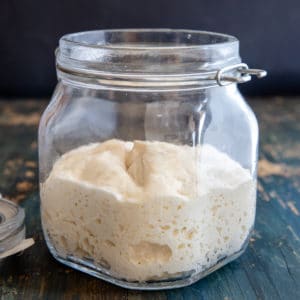
Italian Sour Dough Starter – Lievito Madre Recipe
Ingredients
STEP 1
- 105 grams all purpose or bread flour (unbleached) (¾ cup + 1 tablespoon)
- 50 grams water lukewarm chlorine free water (85F/40C) (3⅓ tablespoons)
- 1/2 teaspoon honey
STEP 2 -11
- 105 grams all purpose or bread flour (unbleached)
- 50 grams water lukewarm chlorine free water (85F/40C)
Instructions
STEP 1
- In a small bowl mix together the lukewarm water and honey, then add the flour and make a non sticky dough ball. Mark with a cross. Then place in a large glass jar, place lid on top but do not close. Let sit in a warm draft free area for 48 hours.
STEP 2
- Remove 100 grams of the dough, it's best to remove the top dry part of the dough, then keep 100 grams of the remaining dough (discard anything over the 100 grams), place in a bowl and add the flour and water, knead to form a compact dough, make a cross. Place in the jar (which has been cleaned, rinsed well and dried). Cover lightly and let rest again for 48 hours.
STEP 3
- Again remove 100 grams of the dough, it's best to remove the top dry part of the dough, then keep 100 grams of the remaining dough (discard anything over the 100 grams) place in a bowl and add the flour and water, knead to form a compact dough, make a cross. Place in the jar (which has been cleaned, rinsed well and dried). Cover lightly and let rest again for 48 hours.
STEP 4
- Again remove 100 grams of the dough, it's best to remove the top dry part of the dough, then keep 100 grams of the remaining dough (discard anything over the 100 grams), place in a bowl and add the flour and water, knead to form a compact dough, make a cross. Place in the jar (which has been cleaned, rinsed well and dried). Cover lightly and let rest again for 48 hours.
STEP 5
- Again remove 100 grams of the dough, it's best to remove the top part of the dough, then keep 100 grams of the remaining dough (discard anything over the 100 grams), place in a bowl and add the flour and water, knead to form a compact dough, make a cross. Place in the jar (which has been cleaned, rinsed well and dried). Cover lightly and let rest again for 24 hours.
STEP 6
- Again remove 100 grams of the dough, it's best to remove the top part of the dough, then keep 100 grams of the remaining dough (discard anything over the 100 grams), place in a bowl and add the flour and water, knead to form a compact dough, make a cross. Place in the jar (which has been cleaned, rinsed well and dried). Cover lightly and let rest again for 24 hours.
STEP 7
- Again remove 100 grams of the dough, it's best to remove the top part of the dough, then keep 100 grams of the remaining dough (discard anything over the 100 grams), place in a bowl and add the flour and water, knead to form a compact dough, make a cross. Place in the jar (which has been cleaned, rinsed well and dried). Cover lightly and let rest again for 24 hours.
STEP 8
- Again remove 100 grams of the dough, it's best to remove the top part of the dough, then keep 100 grams of the remaining dough (discard anything over the 100 grams), place in a bowl and add the flour and water, knead to form a compact dough, make a cross. Place in the jar (which has been cleaned, rinsed well and dried). Cover lightly and let rest again for 24 hours.
STEP 9
- Again remove 100 grams of the dough, it's best to remove the top part of the dough, then keep 100 grams of the remaining dough (discard anything over the 100 grams), place in a bowl and add the flour and water, knead to form a compact dough, make a cross. Place in the jar (which has been cleaned, rinsed well and dried). Cover lightly and let rest again for 24 hours.
STEP 10
- Again remove 100 grams of the dough, it's best to remove the top part of the dough, then keep 100 grams of the remaining dough (discard anything over the 100 grams), place in a bowl and add the flour and water, knead to form a compact dough, make a cross. Place in the jar (which has been cleaned, rinsed well and dried). Cover lightly and let rest again for 24 hours.
STEP 11
- Again remove 100 grams of the dough, it's best to remove the top part of the dough, then keep 100 grams of the remaining dough (discard anything over the 100 grams), place in a bowl and add the flour and water, knead to form a compact dough, make a cross. Place in the jar (which has been cleaned, rinsed well and dried). Cover lightly and let rest again for 24 hours.
STEP 12
- Ready to use!
I Have done the stiff starter , how do I feed it ? do i still discard 100g and how do I feed it in ratio once i have taken 100g starter to bake with. I am still learning
Hi Liana, there is a whole section on what and how to use a mature starter. Look at the section How to bake with a refrigerated starter. If you have any questions let me know.
I am just starting this today as an alternative to my normal wet starter. However, I have made a couple of changes. I am using 100% durum wheat (semola rimacinata). But since Durum wheat has high water absorption, I am working at 60% hydration rather than 50%.
I noticed elsewhere that bakers in Southern Italy, in Altamura, go for this kind of percentage. We shall see!
I will then use it for Pane Tipo di Altamura, but it won’t be in a wood fired oven, sadly!
Hi CC thanks let me know how it goes. Have a great week.
Hello, regrettably, I was unable to feed my starter on the very last step (step 11). Should I go ahead and feed it today (the following morning) as if today was step 11, call it ready to use, or is it now time to just start the process over? And for clarity, under “when storing in the fridge” how often is that feeding process happening- Or am I not feeding it again at all until I’m ready to bake?
Hi Nicole, yes you can feed it today. Once you place it in the fridge you don’t feed it again until you use it, although try to use it at least once every 2 weeks. 🙂
I started my LM in the middle of October and I LOVE it!! I accidentally killed it once but I had backup in the fridge to replace it. I have a dessert style waffle recipe that I use and enjoy. I had to mash a few recipes together to come up with it. I really need more recipes, though! Any tips on what to look for or how to convert a regular sourdough recipe into one with a lievito madre?
Hi Jennifer, thank so much, glad you like it. So if I was converting a regular sourdough starter recipe to use with a lievito madre starter I would just add more lukewarm water to the recipe as I was kneading (with the dough hook) to arrive at the dough that they say in the recipe. Here are a couple of links that might help. https://www.sourdough.co.uk/sourdough-hydration-calculator/ http://brdclc.com/?flour=1000&water=75&salt=2&leaven=20. Hope that helps. Let me know. Or you can take some of your LM starter and stir it with some water before adding it to the dough. Some people also say you really don’t have to convert anything just follow the recipe and basically add some additional water if needed.
Thanks! This helps a lot. Please consider posting more recipes to use with the LM!
Hi Jennifer, you’re welcome, glad it helped. I actually have a LM bread recipe to post. And yes I will take it out of the fridge and make some more things with it! Take care.
Hi, I started a lievito madre and have just completed the first 48hs. Now I saw that some mold (green and white) developed on top of the dried out skin… I was under the impression that I had left the jar cracked open. Do I have to start over? Or can I just use the inside of the ball?
THanks for your help!
Hi Wanda, I would just remove it, but check to make sure it hasn’t gone further down, then you should definitely start over, Is your house very warm? Try placing it in a cooler room. Let me know.
Hi I am into the last step so if I am not using I will have to store in my fridges. How long will be the next feeding?
Hi Edwin, it’s all written in the post, look under “When storing in the Fridge”. Hope that helps.
Thank you for explaining detail in building italian starter. I have a question about Italian starter. I read we need to give it a sugar bath in the maintenance of the LM to wash the acidity because it taste more sour? How often this procces has to be done and how to do it? Thank you for any explanation!
Hi Anna, so I had never heard of that before but this is what I discovered. Pour room temperature water (70F/20C) into a large bowl and add a pinch of sugar. Take your sourdough out of the fridge and cut it into pieces, then take each piece in your hands and press it lightly to release all the carbon dioxide that has formed inside before placing it inside the bowl. Do this for all the pieces then leave them in the solution of water and sugar for 20 minutes. After the time has passed, squeeze the pieces of yeast to eliminate the excess water and weigh them on a kitchen scale, then put all the pieces in a bowl and proceed with the refreshment (normally the refreshment is done with a hydration of 50%, but in this case, since there is still a little water that you used for the bath, I suggest you refresh it with a hydration of 40% or you could add 50% if you prefer, so for 100 grams of mother yeast, add 40 grams of water and 100 gr of flour). Leave it a couple of hours at room temperature before placing in the fridge. They do this not only for the acid balance but also to strengthen it. Interesting. I hope that’s what you were looking for. 🙂
Can you turn a already fermented sourdough starter into Lievito starter by hydrating it less and possibly adding in honey the first feeding?
Hi Nancy yes you probably could, but I think since it is already mature you don’t even need to add honey, just had less water. Let me know how it goes.
Just to confirm, it was meant to be 5 stars in my comment and not 4, it seems I really have to get a new iPad
Clicked “Reply” to your comment; didn’t do anything, so hope it follows your comment.
1. Have to start over. I got to Step 5 and found the dough had white, fuzzy growth, so threw the whole thing away. Wasn’t sure whether this was some harmless yeast. Could it have been because I placed a lid on and it became too moist?
2. I did measure using a scale. At first the dough is very pliable and easy to handle, however, it becomes VERY sticky prior to next step. Is this normal? How do you keep the dough from sticking all over your fingers, spoon—oil/flour your fingers?
Thank you.
Hi Elizabeth, yes just cover it lightly, you could actually cover it with a piece of plastic wrap, just drape it over the jar or bowl. And yes that’s perfect when it becomes sticky, use a spatula to remove it from the jar, don’t oil your fingers, if you do use your hands damping your hands with water will help with the stickiness. Let me know how it goes.
SO thankful you posted this recipe! I have been looking for something similar for awhile. While I understood it for the most part, your directions were somewhat confusing. For example, you state, “Remove 100 grams of the dough, it’s best to remove the top part of the dough, discard anything over the 100 grams…” Are you saying to remove and KEEP the top part of the dough equal to 100 gr.? Or remove (and discard) the top part of the dough while keeping 100 gr. for the next step? I have found that the top portion is dryer so I assumed it was to remove and DISCARD the top part. Please clarify. Thank you. Love your recipes.
Hi Elizabeth, sorry it was confusing but yes remove the top dry part to start and then keep 100 grams for the next step. I will change the wording. Let me know how it goes. Take care.
Very excited to try this and looking forward to the recipes to come featuring its use!
Thanks Regina, I added a focaccia recipe to the post, I will be posting a couple of more in the next couple of weeks. 🙂
Can you use maple syrup instead of honey or does it need to be honey?
Hi Clare, yes it should be honey and not maple syrup for this. 🙂
Just to follow up on your question, maple Sirup should work as well. Also, you could use the juice of a ripe apple, or soak raisins in water for a day or so and use some of the water for your starter.
Don’t be shy to try , eventually you are the lievito‘s boss and not vice versa😀
Hi Tom and yes I have also been told fresh grape juice also. Take care.
Hi, Rosemary. So there is no yeast in the starter? How does it rise? Or is it merely resting? Thanks.
Hi Pamela, it natural yeast and it rising over time.
Where is a bread recipe to use this starter in?
Hi Jackie, those are coming.